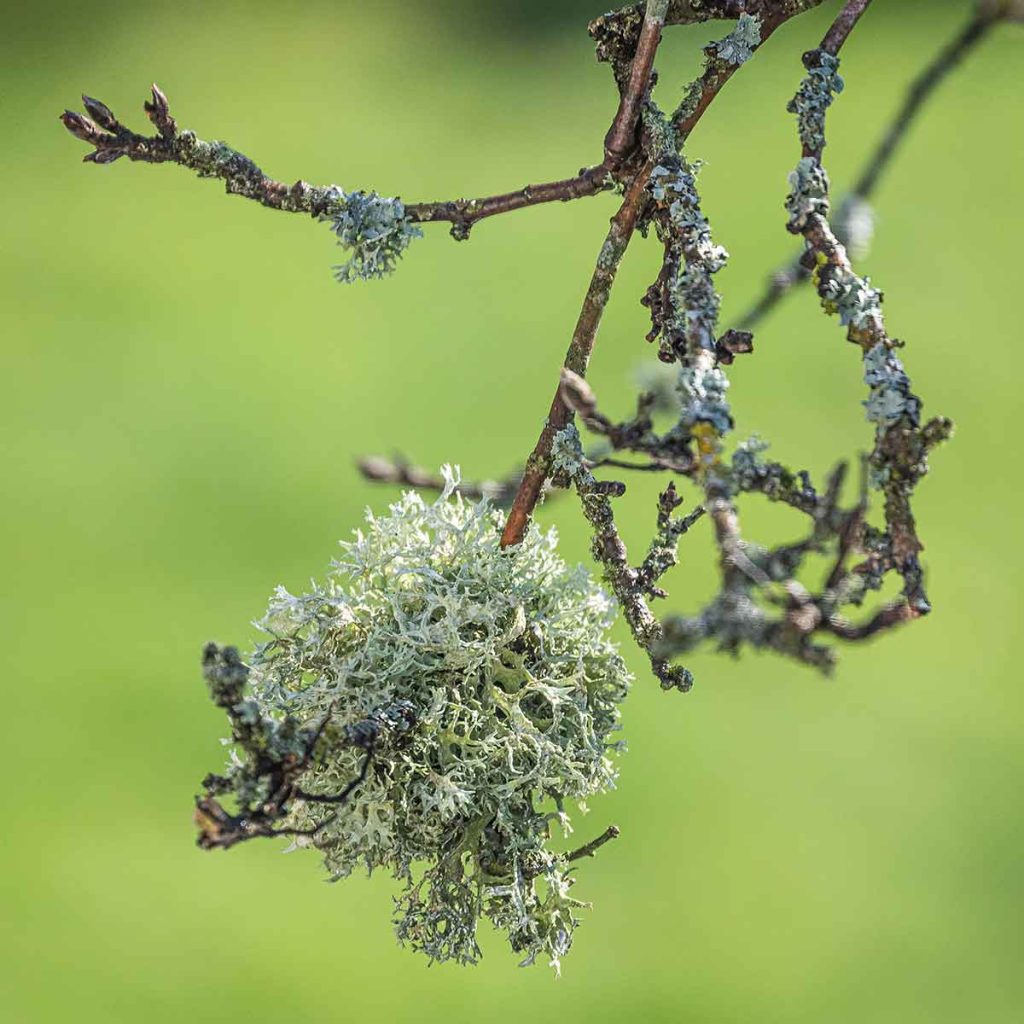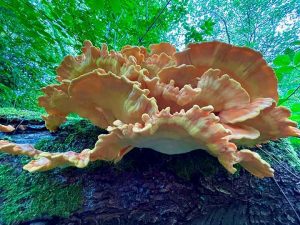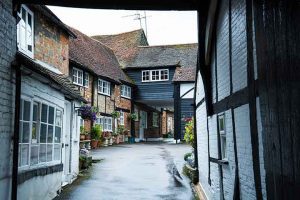…in the Chilterns.
As winter in the Chilterns edges towards spring, there’s colour to be found where you least expect it. I’m not referring to flowers or the leaves that are now littering the ground. I’m talking about lichens, those crusty, stringy forms that are currently decorating our otherwise bleak countryside. Take a few minutes to study them properly and you’ll be astounded at their beauty, complexity, and variety.
I have to admit that I never paid much attention to lichens until I started photographing them last year. I noticed some on the apple trees in my garden and thought they looked interesting, so I took some snaps. Imagine my astonishment when I viewed the photos on my computer screen and realised just what I had. Some lichens were covered in tiny discs. There were leafy structures coated with green dust. Shaggy lichens hung from branches. Several had hairs on the underside. Others sported curled edges that looked embroidered. A number were even shaped like trumpets.
My interest piqued, I began to photograph and study lichens in earnest. This article is the result of my research into a fascinating world right on our doorstep in the Chilterns. I encourage you to have a look yourself, because this time of year is best for spotting them: the trees are bare, and the lichens are abundant and thriving from the moisture provided by rain and snow.
It isn’t a plant, nor is it just a fungus. A lichen is a combination of usually two, occasionally three, parts: an alga (photosynthetic organism) and/or cyanobacteria (photosynthetic bacteria) with a fungus. These join to form a symbiotic association, because each requires something fundamental that the other can give. The alga/cyanobacteria must have shelter. The fungus needs food in the form of carbohydrates, which can be supplied by the alga/ cyanobacteria because they’re photosynthetic. The fungus provides protection and sanctuary in return – symbiosis at its best.
What’s fascinating about the formation of a lichen is how incredibly chancy it is. For each species of lichen, there’s only one combination of a specific alga/cyanobacteria and a particular fungus. If the ideal conditions for their meeting aren’t met, no lichen will form. How the fungus and alga/cyanobacteria find each other and complete their perfect partnership is one of the great mysteries of lichenology.
Many people who find lichens growing on their patios, benches or other surfaces think it’s a good idea to scrub them off. Wrong! Lichens are alive and should be treated with respect. They’re beneficial to the environment in the same way as more familiar plants because their photosynthetic action converts carbon dioxide to oxygen, thus purifying the air. Lichens do little or no harm to the surface on which they’re growing (called a substrate), and many develop very slowly, growing only 1-2mm or less per year. Their only requirements for health and happiness are air, rain, and light, so they’re not asking for much, while giving loads back in return.
They’re beneficial to wildlife, providing food and nesting material for mammals and birds, as well as invertebrates. Humans have also discovered the usefulness of lichens, some of which have antibiotic applications for creating drugs and ointments. The health and beauty industries use lichens for cosmetics, perfumes, toothpaste, and deodorant (although some can cause allergic reactions). Lichens will yield dyes when mixed with other substances.
Once you begin to look, you’ll find them everywhere, in an incredible array of colours and shapes. They can be tiny or quite large, dull, and unobtrusive or brightly coloured. Lichens will attach themselves to a variety of surfaces, from rocks and wooden fences to bushes, tree branches and even cars or roof tiles. They prefer an undisturbed environment, so an excellent place to start looking is in a churchyard, where colourful crusts can be seen decorating gravestones, while leafy or hairy lichens ornament the surrounding trees and bushes.
To make identification easier, lichens can be broken down into five basic types. By far the most common lichens take the form of a crust that adheres quite firmly to the substrate – these so-called crustose lichens make up 75% of all species on the planet. Crustose lichens can be brightly coloured and many have spore-producing structures called apothecia that resemble tiny jam tarts.
A simple unstructured form is called a leprose lichen, which can look like a splash of paint or a powdery deposit. Because it’s not actually attached to the substrate, it’s easy to scrape off – not that you should!
Foliose lichens resemble leaves with two distinct sides. Reproduction and photosynthesis take place on the uppermost side, while underneath, structures called rhizines secure the lichen to the substrate. Some foliose lichens have quite tortured, convoluted shapes that seem to be sprinkled with dust – these reproductive granules are called soredia and are a combination of algal and fungal cells. Fragments of these soredia, blown about by the wind or carried on the coats of animals (or people) that brush past them, can easily develop into new lichens if they land in a suitable place, because they already contain both partners of the symbiotic relationship.
Fruticose lichens are varied and delightful, with several resembling a small bush or a hairy beard. They attach to the substrate at a single point called a holdfast and you can easily detach, which is why you might see them rolling in the woodlands like tumbleweed. When I find them, I usually pick them up and stick them on a convenient branch, so they don’t get trampled.
Squamulose lichens consist of two parts. Patches of crinkly green squamules (scales) give rise to narrow, often bent podetial (hollow stalks) which sometimes have a small cup at the end. Some look like miniature golf tees or Shrek’s ears. Others have red ‘bobbles’ on top and are known as ‘devil’s matchsticks. Look for these in moss on the side of trees and stumps, and on rotting wooden fences.
I hope you’ll search for lichens when you next ramble in the Chiltern countryside. It’s a great focus when hiking with children, who seem to enjoy spotting the extravagant shapes and colours, and sometimes forget how far they’re walking! Give them each an inexpensive hand lens (×10 magnification is fine), so they can become a Sherlock Holmes of the natural world.
In addition to studying lichens in books and on the internet, I’ve had considerable help from expert lichenologists who have willingly and patiently assisted me with sometimes difficult identifications. In particular I’d like to thank Mike Simms, Senior Curator of Natural Sciences at National Museums Northern Ireland, and Martin Butler, the Bedfordshire County Recorder for Lichens. For further information, go to The British Lichen Society: britishlichensociety.org.uk. There are also many knowledgeable lichen lovers and scientists on the Facebook page Lichen spotters UK who will assist with identifications if you post good photographs and ask for help. I post daily photographs of the natural world on Instagram and you can contact me through my website, lindaseward.com, and at:
instagram.com/quiltmaniac1/
lindaquilter.myportfolio.com
facebook.com
amazon.co.uk/Linda-Seward/





